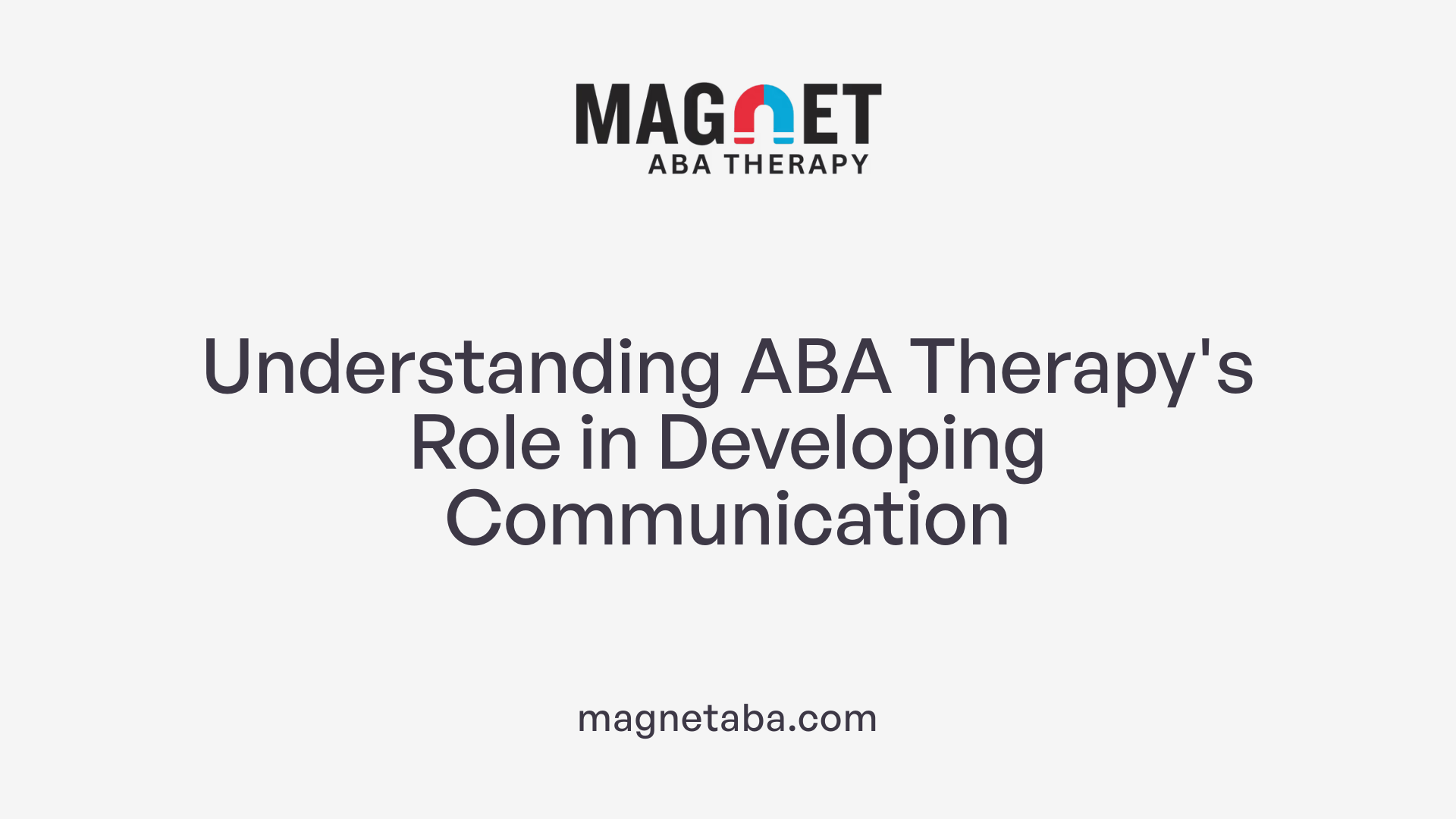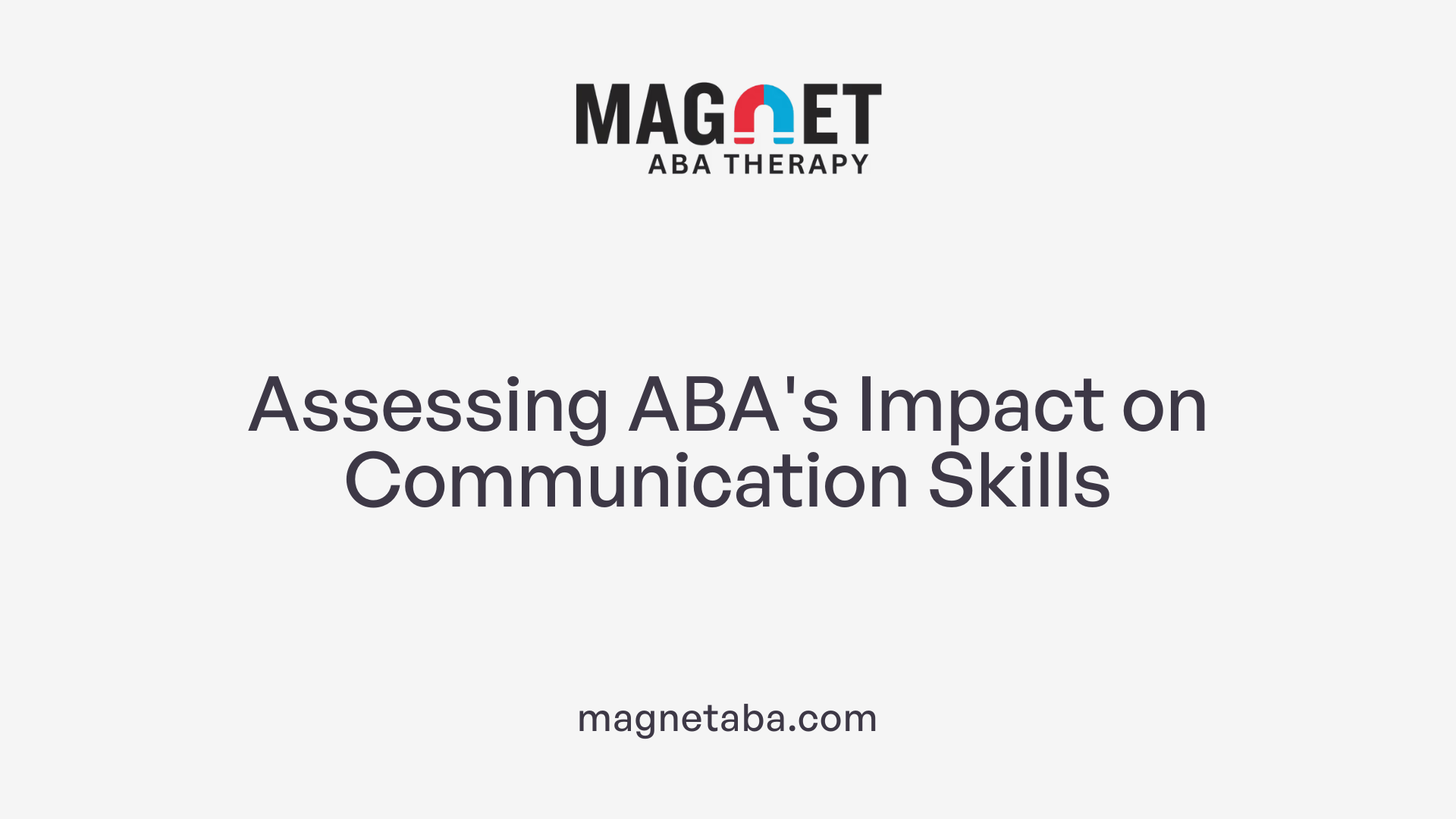Understanding ABA and Its Role in Autism Support
Applied Behavior Analysis (ABA) therapy has long been recognized as a cornerstone in supporting individuals with autism spectrum disorder (ASD). Through scientifically grounded methods, ABA targets a broad range of skills, with a special focus on communication development. This article explores how ABA fosters communication growth, who provides these vital services, the methods used, and the effectiveness and ethical considerations surrounding this therapy.
What Is ABA Therapy and Its Role in Communication Development?

Definition of ABA Therapy
Applied Behavior Analysis (ABA) therapy is a science-based approach focused on understanding and changing behavior through learning principles. Developed in the 1960s, ABA aims to increase helpful behaviors while reducing behaviors that hinder learning, especially in individuals with autism.
Scope of ABA in Autism Treatment
ABA supports a wide range of developmental areas including language, social skills, attention, memory, and academics. Therapy uses techniques like positive reinforcement and behavior analysis to promote meaningful change. Programs are designed by board-certified behavior analysts (BCBAs) who tailor goals based on thorough assessments.
Communication Skill Development Within ABA
Communication is a major focus of ABA, aiming to improve both verbal and non-verbal skills. ABA incorporates augmentative and alternative communication (AAC) methods such as PECS (Picture Exchange Communication System), speech-generating devices, and sign language to support those with communication challenges. These tools help children request, label, and engage more effectively.
Individualization of ABA Programs
ABA therapy is personalized for each child’s skill level and preferences. Behavior analysts develop specific intervention plans using strategies like discrete trial training and naturalistic methods to fit unique learning styles. Therapists and families collaborate closely to reinforce progress in real-life settings.
Early Intervention and Therapy Intensity
Research suggests that intensive ABA therapy—typically 25 to 40 hours weekly for one to three years—yields the best outcomes when started early. Early and consistent intervention can lead to significant gains in intellectual functioning, language, and social behavior, helping children integrate more fully into their communities.
Who Provides ABA Therapy and Their Professional Qualifications?

Who provides ABA therapy, and what qualifications do these professionals typically have?
ABA therapy is delivered by a team of trained professionals including Board Certified Behavior Analysts (BCBAs), Registered Behavior Technicians (RBTs), and behavior therapists.
BCBAs are the lead specialists who design individualized ABA programs based on thorough assessments of each client’s skills and preferences. They generally hold a master’s degree or higher in behavior analysis or a related field. To earn BCBA certification, candidates must complete extensive supervised fieldwork—often between 1,500 and 2,000 hours—and pass a rigorous exam administered by the Behavior Analyst Certification Board (BACB). Many states also require licensure, which involves additional education and testing.
RBTs provide direct therapy under BCBA supervision. They receive specific training to implement behavior plans, often through a certificate program that includes coursework and competency assessments. Other therapists involved in ABA programs may have backgrounds in psychology, education, or speech-language pathology and collaborate closely with BCBAs.
ABA services are provided across diverse settings including homes, schools, clinics, and community environments. This flexibility allows therapy to be tailored to the individual's needs in natural or structured contexts.
Throughout therapy, BCBAs oversee treatment progress and ensure adherence to evidence-based practices while coordinating with other team members. This multidisciplinary supervision and collaboration optimize outcomes for individuals receiving ABA therapy.
Techniques and Strategies to Support Communication in ABA

What are the common techniques and methods used in ABA therapy to address behavioral challenges in autism?
ABA therapy employs several structured and naturalistic techniques to foster communication and manage behaviors effectively. One widely used method is Discrete Trial Training (DTT), which provides repetitive and focused practice on specific skills through clear instructions and immediate reinforcement. This method helps build foundational skills step-by-step.
The Antecedent-Behavior-Consequence (ABC) model is fundamental in ABA. It involves analyzing what happens before a behavior (antecedent), the behavior itself, and what follows (consequence), helping therapists understand triggers and outcomes to modify behaviors efficiently.
Naturalistic approaches such as Pivotal Response Treatment (PRT) incorporate learning within everyday activities, promoting motivation and generalized skill use in real-world contexts. These strategies seek to enhance engagement and functional communication naturally.
A core part of ABA communication support is the use of Augmentative and Alternative Communication (AAC) systems. These include:
- Picture Exchange Communication System (PECS): Uses pictures and symbols to teach functional communication by exchanging images, crucial for early communication development.
- Speech-Generating Devices (SGDs): Portable electronic tools that produce voice output, facilitating social interaction and expressive abilities.
- Communication Boards: Low- or high-tech options offering a visual means to communicate, often useful as bonding tools.
- Sign Language: A manual language system that can be very effective though requires significant learning effort and is not universally applicable.
ABA practitioners carefully tailor interventions to individual strengths and needs. This includes combining highly structured methods like DTT with more flexible, naturalistic teaching. Such a personalized approach ensures communication goals are meaningful, achievable, and integrative.
These strategies together provide a comprehensive toolkit within ABA to promote language development, social communication, and adaptive behaviors in children with autism, backed by extensive evidence supporting their effectiveness.
Evaluating the Effectiveness and Impact of ABA on Communication Development

How effective is ABA therapy in improving the developmental outcomes of individuals with autism?
ABA therapy is widely recognized as an evidence-based intervention that significantly benefits individuals with autism spectrum disorder (ASD). Research has demonstrated that intensive ABA therapy, often involving 25-40 hours per week over one to three years, can lead to notable improvements in language, social interaction, and adaptive behaviors.
Research evidence supporting ABA effectiveness
Studies, including meta-analyses and single-case experimental designs, support ABA’s effectiveness in enhancing communication and reducing problem behaviors. The US Surgeon General and the American Psychological Association have endorsed ABA as a best practice treatment for autism. Key findings include gains in intellectual functioning, language development, social skills, and attention.
Improvements in language, social interaction, and adaptive behaviors
ABA programs use techniques like positive reinforcement, discrete trial training, and naturalistic interventions to teach functional communication and social skills. Applied behavior analysts incorporate augmentative and alternative communication (AAC) methods—such as PECS and speech-generating devices—to boost communication abilities. These interventions help children improve requesting, labeling, emotion recognition, and pragmatic language skills.
Importance of individualized and intensive therapy
Creating tailored ABA programs based on detailed assessments ensures that interventions meet each individual's needs and preferences. These programs adjust antecedents and consequences to encourage helpful behaviors while reducing harmful ones. The involvement of qualified behavior analysts and trained therapists ensures professional delivery and monitoring.
The role of parental involvement and generalization across settings
Parental participation is vital for reinforcing skills learned in therapy across various environments, including home, school, and community. ABA therapy emphasizes generalization strategies so that social and communication gains extend beyond clinical sessions.
Calls for further long-term research and quality of life measures
While the evidence base is strong, experts highlight the need for larger-scale, prospective randomized controlled trials to better understand long-term outcomes and overall quality of life (QoL) impacts. Current research is increasingly focusing on rigorous designs and broader evaluations beyond immediate skill acquisition.
| Aspect | Highlights | Notes |
|---|---|---|
| Research Support | Meta-analyses, endorsements by national organizations | Strong base but calls for more large RCTs |
| Language & Communication Improvements | Gains in speech, AAC use, requesting, labeling | PECS and SGDs particularly effective |
| Social & Adaptive Behavior Gains | Better emotion recognition, social initiation, and conflict resolution | Integral to comprehensive ABA programming |
| Individualization & Intensity | Customized goals, 25-40 hours weekly for 1–3 years | Key for maximizing therapy outcomes |
| Parental Involvement & Generalization | Skills reinforced at home and school | Essential for real-world impact |
| Future Research Needs | More RCTs, QoL assessments, longer follow-ups | To strengthen evidence and treatment evaluation quality |
Navigating Challenges and Ethical Considerations in ABA Communication Interventions

What are some common challenges families face when engaging with ABA therapy services?
Families often encounter significant challenges when accessing ABA therapy. The high cost of intensive ABA programs is a major concern, with many needing to navigate insurance coverage complexities or seek Medicaid support. Additionally, the considerable time commitment—often requiring 25 to 40 hours per week—can be difficult to balance with daily family routines and school schedules.
Finding qualified, well-trained therapists such as Board Certified Behavior Analysts (BCBAs) and Registered Behavior Technicians (RBTs) nearby adds another layer of difficulty. Collaboration between therapists and family members is necessary for success but can be demanding to maintain consistently.
Another common challenge relates to perceptions of traditional ABA rigidity. Some families worry that strictly structured approaches might suppress natural behaviors or prioritize conformity over meaningful skill development. Emotional and cultural considerations also play a role, as behavior-focused interventions may clash with family values or lead to stress. Nevertheless, many families find modern ABA approaches to be more individualized, culturally sensitive, and focused on empowering children to engage meaningfully with their communities.
Are there ethical considerations in the application of ABA therapy for autism, and how are these addressed by professionals?
Ethics form the foundation of responsible ABA practice. Professionals adhere to strict ethical codes, like those from the Behavior Analyst Certification Board (BACB), to ensure that interventions respect the dignity, rights, and individuality of each person.
Obtaining informed consent with transparent communication about goals, methods, and possible outcomes is a mandatory step. Treatment plans are carefully tailored to each individual’s unique needs, preferences, and cultural context, ensuring person-centered and culturally competent care.
Continuous data collection and progress monitoring prevent harm by identifying and eliminating ineffective or harmful practices. Practitioners work vigilantly to avoid prompt dependency, which can undermine independence, and strive to maintain the dignity of the learner throughout training.
Professional responsibilities also include maintaining confidentiality, avoiding conflicts of interest, and engaging in ongoing education to stay current with ethical standards and evidence-based methods. Ultimately, ABA therapists are committed to acting in the best interest of their clients by balancing scientific rigor with compassion and respect for individual diversity.
Supporting Communication Growth Through Collaborative ABA Practices
Applied Behavior Analysis remains a highly effective, evidence-based approach to enhancing communication skills in individuals with autism. By employing a diverse range of intervention strategies, including augmentative and alternative communication tools and individualized behavior plans, ABA therapists work collaboratively with families and other professionals to foster meaningful improvements. Despite challenges related to accessibility, time, and ethical concerns, ongoing research and professional standards continue to refine and advocate for person-centered, respectful care. Supporting communication development in ABA ultimately requires tailored, compassionate approaches that empower individuals and promote lasting skills across their daily lives.
References
- Applied Behavior Analysis (ABA)
- 4 Methods for Increasing Communication Within Applied ...
- Applied Behavior Analysis and Communication Services
- Beyond Behavior: ABA Therapy's Impact on Social and ...
- Applied Behavior Analysis in Children and Youth with Autism ...
- The Controversy Around ABA
- The effectiveness of applied behavior analysis program ...
- Applied Behavior Analysis (ABA)











